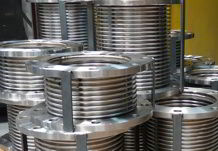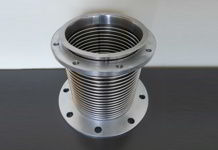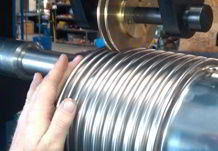EJMA-The Expansion Joint Manufacturers Association, Inc.
The Expansion Joint Manufacturers Association is an organization of established manufacturers of metal bellows type expansion joints.
EJMA was founded in 1955 to establish and maintain quality design and manufacturing standards. These Standards combine the knowledge and experience of the association’s Technical Committee and are available to assist users, designers, and others in the selection and application of expansion joints for safe and reliable piping and vessel installation.
EJMA carries out extensive technical research and testing on many important aspects of expansion joint design and manufacturing. EJMA 10th Edition is the most current edition and supersedes all previous publications.
Triad Bellows Design and Manufacturing uses bellows design software based on EJMA 10th edition guidelines.
Calculation Results Definitions
Cd: The factor read from the EJMA Figure C26 (or ASME VIII) for the listed curve number and x value. It is used in specific design calculations to relate U-shaped bellows convolution segment behavior to a simple strip beam.
Cf: The factor read from the EJMA Figure C25 (or ASME VIII) for the listed curve number and x value. It is used in specific design calculations to relate U-shaped bellows convolution segment behavior to a simple strip beam.
Cp: The factor read from the EJMA Figure C26 (or ASME VIII) for the listed curve number and x value. It is used in specific design calculations to relate U-shaped bellows convolution segment behavior to a simple strip beam.
S1: Bellows tangent circumferential membrane stress due to internal pressure. In case of external pressure the reinforcing effect of a possible external collar is excluded.
S1: Collar circumferential membrane stress due to internal pressure. In case of external pressure the reinforcing effect of a possible external collar is excluded.
S2: Bellows circumferential membrane stress due to pressure.
S3: Bellows meridional membrane stress due to pressure.
S4: Bellows meridional bending stress due to pressure.
S5: Bellows meridional membrane stress due to deflection.
S6: Bellows meridional bending stress due to deflection.
Rated Max Axial: The maximum amount of movement (axial extension, axial compression, lateral deflection, angular rotation, or any combination thereof) which an Expansion Joint is capable of absorbing. This rating may be different for each size, type and make of Expansion Joint and is established by the manufacturer.
Total Equivalent Max Axial: Bellows are rated by the manufacturer in terms of maximum allowable axial displacement per convolution, ec and ee. The design of every Expansion Joint must be such that the total displacement per convolution from all sources does not exceed the rated values.
Bellows Allowed Stress: Allowable material stress at design temperature, unless otherwise specified, from the applicable code.
Bellows E at Temperature: Modulus of Elasticity at design temperature, unless otherwise specified, for material.
Bellows Yield at Temp: Yield strength at design temperature, unless otherwise determined, of bellows material after completion of bellows forming and any applicable heat treatment.
Axial Working Spring Rate: In order to evaluate the loads upon piping, supports, or equipment, it is necessary to determine the axial forces and moments required to move an Expansion Joint. The bellows resistance factor or working spring rate is shown in lbs per inch of compression or extension.
Lateral Working Spring Rate: In order to evaluate the loads upon piping, supports, or equipment, it is necessary to determine the lateral forces and moments required to move an Expansion Joint. The bellows resistance factor or working spring rate is shown in lbs per inch of lateral offset.
Bending Working Spring Rate: This is the displacement of the longitudinal axis of the Expansion Joint from its initial straight line position into a circular arc. Angular rotation is occasionally referred to as rotational movement and is shown in LBS per degree. This is not torsional rotation.
Limiting Column Instability: Calculated maximum pressure in PSIG before expansion joint may squirm because of column instability.
Excessive internal pressure may cause a bellows to become unstable and squirm. Squirm is detrimental to bellows performance in that it can greatly reduce both fatigue life and pressure capacity.
Column squirm is defined as a gross lateral shift of the centre section of the bellows. This condition is most associated with bellows which have a relatively large length-to-diameter ration and is similar to the buckling of a column under compressive load.
Limiting Inplane Instability: Calculated maximum pressure in PSIG before expansion joint may squirm because of inplane instability.
In-plane squirm is defined as a shift or rotation of the plane of one or more convolutions such that the plane of these convolutions is no longer perpendicular to the axis of the bellows. It is characterized by tilting or warping of one or more convolutions. This condition is predominantly associated with high meridional bending stress at the root and crest of the convolutions.
Allowed Cycles: The fatigue life expectancy can be defined as the total number of complete cycles which can be expected from the expansion joint. A cycle is defined as one complete movement from the initial position in the piping system to the operating position and back to the initial position. Cycle Life is theoretical and is dependent upon the maximum stress range to which the bellows is subjected. The fatigue life expectancy of an expansion joint is affected by various factors such as: operating pressure, operating temperature, the material from which the bellows is made, the movement per convolution, the thickness of the bellows, the convolution pitch, the depth and shape of the convolution. Any change in these factors will result in a change in the life of the Expansion Joint. The work hardening of austenitic stainless steel, induced during the forming of convolutions, generally improves the fatigue life of an Expansion Joint often to a marked degree.
Convolution Depth w: Convolution height less the bellows material thickness.
Bellows Length Le: Bellows convoluted length (Lb) plus the length of the bellows tangent ends or necks.
Bellows Length Lb: Bellows convoluted length or live length.
Bellows Length Lu: Distance between outermost ends of the convolutions in a universal expansion joint. Zero length is shown for single bellows.
Total Length: Total length of the expansion joint including the possible pipe ends. It is calculated as either Lb or Lu plus length of pipe ends.
Thickness tp: Bellows material thickness for one ply, corrected for thinning during the forming of the bellows convolutions.
Effective Area Ae: Axial force or pressure thrust is caused by the internal pressure of the bellows. This is calculated on the full effective cross section of the bellows known as the effective area. Pressure thrust can be calculated by multiplying the working pressure by the effective area (PSIG x Ae).
Factor Ku: Factor establishing relationship between the equivalent axial displacement per convolution due to lateral deflection.
Thrust Force: Axial force or thrust caused by the internal pressurization of the bellows. The thrust force is calculated by multiplying the working pressure by the effective area (PSIG x Ae).




